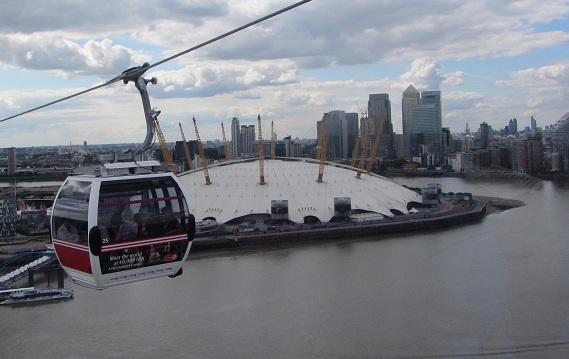You may have often asked yourself: "Just how can I quantify the carrying capacities of various modes of transport in London?" This page is going to answer your question. The idea was inspired by a press release from Transport for London about the new Emirates "Air line"[1] cable car across the Thames. TfL said that the system would have "the capacity of 50 buses per hour". Although the cable car is great fun, this figure is clearly bogus. So how do we calculate the real number?
The key concept to quantify transport capacities is the speed per passenger-mile. This is a combination
of the speed of the underlying service and the number of passengers that it can carry. We can define it
as the product of the speed and the number of passengers. Or alternatively
Here is a table showing various ways of travelling in London, along with their capacities.
| Mode | Start | Destination | Distance (miles) | Scheduled Time (hours) | Speed (mph) | Max Passengers | Capacity (pmph) |
|---|---|---|---|---|---|---|---|
| Bus #19 | King's Cross | Victoria | 2.55 | 0.717 | 3.6 | 91[2] | 324 |
| Bus #38 (New Bus) | Angel | Victoria | 3.04 | 0.650 | 4.7 | 87[3] | 407 |
| Emirates Cable Car | Royal Docks | Greenwich Peninsula | 0.61 | 0.117 | 5.2 | 340[4] | 1,778 |
| Picadilly Line | King's Cross | South Kensington | 3.38 | 0.267 | 12.7 | 684[5] | 8,670 |
| Northern Line | King's Cross | London Bridge | 2.42 | 0.183 | 13.2 | 914[6] | 12,065 |
| Victoria Line | King's Cross | Victoria | 2.55 | 0.167 | 15.3 | 1,448[7] | 22,154 |
| East Coast Trains | King's Cross | Edinburgh Waverley | 332 | 4.517 | 73.5 | 544[8] | 39,987 |
| BA Boeing 747 | London Heathrow | New York Kennedy | 3,446 | 7.700 | 447.5 | 345[9] | 154,399 |
Distances are "crow-fly" straight lines(or geodesics); journey timings are based on published timetables by their operators; and passenger numbers come from a variety of listed sources.
The Transport for London press release gives information about the cable car's capacity:
It would take around five minutes to travel between the O2 and ExCeL cutting current travel times. The cable car could provide a crossing every 30 seconds carrying up to 2,500 passengers per hour in each direction, equivalent to the capacity of 50 buses per hour.
Transport for London's figure seems to be based on the following assumptions and calculations:
The major flaw in this calculation is that it omits the fact that the 2,500 passengers have only been carried about 0.6 miles each. But in one hour the 50 buses could have carried their 2,500 passengers about 4 miles. So the buses have been much more effective than the cable car.
Using the table, we can quantify the true capacities. The entire cable car system can transport about 1,800 passenger-miles per hour. This is equivalent to about five London buses (using an average capacity of 365 pmph per bus), rather than fifty. So Transport for London are overstating the number of equivalent buses by a factor of about ten.
We can also look at cost effectiveness. A new London bus costs £315,000[10], so five of them would cost around £1.5 million. The cost of the cable car system is reported[11] at £60 million. Which is about 40 times more expensive than buying the buses. And, per passenger-mile/hour, about 25 times more expensive than paying £210 million for a brand-new Boeing 747.
But it is a great view.
